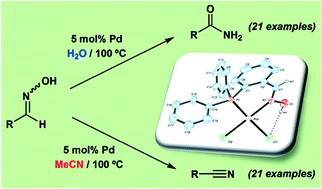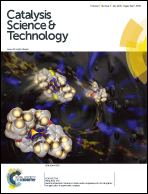Palladium(ii) complexes with a phosphino-oxime ligand: synthesis, structure and applications to the catalytic rearrangement and dehydration of aldoximes†
Abstract
The treatment of [PdCl2(COD)] (COD = 1,5-cyclooctadiene) with 1 and 2 equivalents of 2-(diphenylphosphino)benzaldehyde oxime in dichloromethane at room temperature led to the selective formation of [PdCl2{κ2-(P,N)-2-Ph2PC6H4CH![[double bond, length as m-dash]](https://www.rsc.org/images/entities/char_e001.gif) NOH}] (1) and [Pd{κ2-(P,N)-2-Ph2PC6H4CH
NOH}] (1) and [Pd{κ2-(P,N)-2-Ph2PC6H4CH![[double bond, length as m-dash]](https://www.rsc.org/images/entities/char_e001.gif) NOH}2][Cl]2 (2), respectively, which represent the first examples of Pd(II) complexes containing a phosphino-oxime ligand. These compounds, whose structures were fully confirmed by X-ray diffraction methods, were active in the catalytic rearrangement of aldoximes. In particular, using 5 mol% complex 1, a large variety of aldoximes could be cleanly converted into the corresponding primary amides at 100 °C, employing water as solvent and without the assistance of any cocatalyst. Palladium nanoparticles are the active species in the rearrangement process. In addition, when the same reactions were performed employing acetonitrile as solvent, selective dehydration of the aldoximes to form the respective nitriles was observed. For comparative purposes, the catalytic behaviour of an oxime-derived palladacyclic complex has also been briefly evaluated.
NOH}2][Cl]2 (2), respectively, which represent the first examples of Pd(II) complexes containing a phosphino-oxime ligand. These compounds, whose structures were fully confirmed by X-ray diffraction methods, were active in the catalytic rearrangement of aldoximes. In particular, using 5 mol% complex 1, a large variety of aldoximes could be cleanly converted into the corresponding primary amides at 100 °C, employing water as solvent and without the assistance of any cocatalyst. Palladium nanoparticles are the active species in the rearrangement process. In addition, when the same reactions were performed employing acetonitrile as solvent, selective dehydration of the aldoximes to form the respective nitriles was observed. For comparative purposes, the catalytic behaviour of an oxime-derived palladacyclic complex has also been briefly evaluated.



 Please wait while we load your content...
Please wait while we load your content...